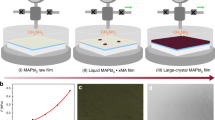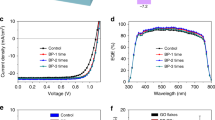Abstract
Perovskite solar cells have attracted significant research efforts due to their remarkable performance, with certified power conversion efficiency now reaching 22%. Solution-processed perovskite thin films are polycrystalline, and grain boundaries are thought to be responsible for causing recombination and trapping of charge carriers. Here we report an effective and reproducible way of treating grain boundaries in CH3NH3PbI3 films deposited by means of a Lewis acid–base adduct approach. We show by high-resolution transmission electron microscopy lattice images that adding 6 mol% excess CH3NH3I to the precursor solution resulted in a CH3NH3I layer forming at the grain boundaries. This layer is responsible for suppressing non-radiative recombination and improving hole and electron extraction at the grain boundaries by forming highly ionic-conducting pathways. We report an average power conversion efficiency of 20.1% over 50 cells (best cell at 20.4%) together with significantly reduced current–voltage hysteresis achieved by this grain boundary healing process.
This is a preview of subscription content, access via your institution
Access options
Subscribe to this journal
Receive 12 digital issues and online access to articles
$119.00 per year
only $9.92 per issue
Buy this article
- Purchase on Springer Link
- Instant access to full article PDF
Prices may be subject to local taxes which are calculated during checkout




Similar content being viewed by others
References
Kim, H.-S. et al. Lead iodide perovskite sensitized all-solid-state submicron thin film mesoscopic solar cell with efficiency exceeding 9%. Sci. Rep. 2, 591 (2012).
Kojima, A., Teshima, K., Shirai, Y. & Miyasaka, T. Organometal halide perovskites as visible-light sensitizers for photovoltaic cells. J. Am. Chem. Soc. 131, 6050–6051 (2009).
Im, J.-H., Lee, C.-R., Lee, J.-W., Park, S.-W. & Park, N.-G. 6.5% efficient perovskite quantum-dot-sensitized solar cell. Nanoscale 3, 4088–4093 (2011).
Liu, M., Johnston, M. B. & Snaith, H. J. Efficient planar heterojunction perovskite solar cells by vapour deposition. Nature 501, 395–398 (2013).
Burschka, J. et al. Sequential deposition as a route to high-performance perovskite-sensitized solar cells. Nature 499, 316–319 (2013).
Stranks, S. D. et al. Electron-hole diffusion lengths exceeding 1 micrometer in an organometal trihalide perovskite absorber. Science 342, 341–344 (2013).
Xing, G. et al. Long-range balanced electron and hole-transport lengths in organic-inorganic CH3NH3PbI3 . Science 342, 344–347 (2013).
Shi, D. et al. Low trap-state density and long carrier diffusion in organolead trihalide perovskite single crystals. Science 347, 519–522 (2015).
Dong, Q. et al. Electron-hole diffusion lengths >175 mm in solution-grown CH3NH3PbI3 single crystals. Science 347, 967–970 (2015).
Kim, H.-S. et al. Mechanism of carrier accumulation in perovskite thin-absorber solar cells. Nature Commun. 4, 2242 (2013).
Yang, W. S. High-performance photovoltaic perovskite layers fabricated through intramolecular exchange. Science 348, 1234–1237 (2015).
Best Research-Cell Efficiencies (National Renewable Energy Laboratory, 2016); http://www.nrel.gov/ncpv/images/efficiency_chart.jpg
Im, J.-H., Jang, I.-H., Pellet, N., Grätzel, M. & Park, N.-G. Growth of CH3NH3PbI3 cuboids with controlled size for high-efficiency perovskite solar cells. Nature Nanotech. 9, 927–932 (2014).
Li, W., Fan, J., Li, J., Mai, Y. & Wang, L. Controllable grain morphology of perovskite absorber film by molecular self-assembly toward efficient solar cell exceeding 17%. J. Am. Chem. Soc. 137, 10399–10405 (2015).
Xiao, M. et al. A fast deposition-crystallization procedure for highly efficient lead iodide perovskite thin-film solar cells. Angew. Chem. 126, 10056–10061 (2014).
Zhou, H. et al. Interface engineering of highly efficient perovskite solar cells. Science 345, 542–546 (2014).
Kim, S. I. et al. Dense dislocation arrays embedded in grain boundaries for high-performance bulk thermoelectrics. Science 348, 109–114 (2015).
Tsen, A. W. et al. Tailoring electrical transport across grain boundaries in polycrystalline graphene. Science 336, 1143–1146 (2012).
van der Zande, A. M. et al. Grains and grain boundaries in highly crystalline monolayer molybdenum disulphide. Nature Mater. 12, 554–561 (2013).
de Quilettes, D. W. et al. Impact of microstructure on local carrier lifetime in perovskite solar cells. Science 348, 683–686 (2015).
Yun, J. S. et al. Benefit of grain boundaries in organic-inorganic halide planar perovskite solar cells. J. Phys. Chem. Lett. 6, 875–880 (2015).
Chen, Q. et al. Controllable self-induced passivation of hybrid lead iodide perovskites toward high performance solar cells. Nano Lett. 14, 4158–4163 (2014).
Ahn, N. et al. Highly reproducible perovskite solar cells with average efficiency of 18.3% and best efficiency of 19.7% fabricated via Lewis base adduct of lead(II) iodide. J. Am. Chem. Soc. 137, 8696–8699 (2015).
Dang, Y. et al. Bulk crystal growth of hybrid perovskite material CH3NH3PbI3 . CrystEngComm 17, 665–670 (2015).
Yang, M. et al. Square-centimeter solution-processed planar CH3NH3PbI3 perovskite solar cells with efficiency exceeding 15%. Adv. Mater. 27, 6363–6370 (2015).
Roldán-Carmona, C. et al. High efficiency methylammonium lead triiodide perovskite solar cells: the relevance of non-stoichiometric precursors. Energy Environ. Sci. 8, 3550–3556 (2015).
Kim, Y. C. et al. Beneficial effects of PbI2 incorporated in organo-lead halide perovskite solar cells. Adv. Energ. Mater. 6, 1502104 (2016).
Manser, J. S. & Kamat, P. V. Band filling with free charge carriers in organometal halide perovskites. Nature Photon. 8, 737–743 (2014).
Yang, Y. et al. Low surface recombination velocity in solution-grown CH3NH3PbBr3 perovskite single crystal. Nature Commun. 6, 7961 (2015).
Yan, W. et al. Stable high-performance hybrid perovskite solar cells with ultrathin polythiophene as hole-transporting layer. Nano Res. 8, 2474–2480 (2015).
Yang, Y. et al. The size effect of TiO2 nanoparticles on a printable mesoscopic perovskite solar cell. J. Mater. Chem. A 3, 9103–9107 (2015).
Wen, X. et al. Morphology and carrier extraction study of organic-inorganic metal halide perovskite by one- and two-photon fluorescence microscopy. J. Phys. Chem. Lett. 5, 3849–3853 (2014).
Yang, Y. et al. Observation of a hot-phonon bottleneck in lead-iodide perovskites. Nature Photon. 10, 53–59 (2016).
Wang, L. et al. Femtosecond time-resolved transient absorption spectroscopy of CH3NH3PbI3 perovskite films: evidence for passivation effect of PbI2 . J. Am. Chem. Soc. 136, 12205–12208 (2014).
Sadhanala, A. et al. Preparation of single-phase films of CH3NH3Pb(I1−xBrx)3 with sharp optical band edges. J. Phys. Chem. Lett. 5, 2501–2505 (2014).
Yu, H., Lu, H., Xie, F., Zhou, S. & Zhao, N. Native defect-induced hysteresis behavior in organolead iodide perovskite solar cells. Adv. Funct. Mater. 26, 1411–1419 (2016).
Agiorgousis, M. L., Sun, Y. Y., Zeng, H. & Zhang, S. Strong covalency-induced recombination centers in perovskite solar cell material CH3NH3PbI3 . J. Am. Chem. Soc. 136, 14570–14575 (2014).
Buin, A. et al. Materials processing routes to trap-free halide perovskites. Nano Lett. 14, 6281–6286 (2014).
Yin, W.-J., Shi, T. & Yan, Y. Unusual defect physics in CH3NH3PbI3 perovskite solar cell absorber. Appl. Phys. Lett. 104, 063903 (2014).
Yin, W.-J., Chen, H., Shi, T., Wei, S.-H. & Yan, Y. Origin of high electronic quality in structurally disordered CH3NH3PbI3 and the passivation effect of Cl and O at grain boundaries. Adv. Electron. Mater. 1, 1500044 (2015).
Xu, J. et al. Perovskite–fullerene hybrid materials suppress hysteresis in planar diodes. Nature Commun. 6, 7081 (2015).
de Quilettes Impact of microstructure on local carrier lifetime in perovskite solar cells. Science 348, 683–686 (2015).
Shao, Y., Xiao, Z., Bi, C., Yuan, Y. & Huang, J. Origin and elimination of photocurrent hysteresis by fullerene passivation in CH3NH3PbI3 planar heterojunction solar cells. Nature Commun. 5, 5784 (2014).
Long, R., Liu, J. & Prezhdo, O. V. Unravelling the effects of grain boundary and chemical doping on electron-hole recombination in CH3NH3PbI3 perovskite by time-domain atomistic simulation. J. Am. Chem. Soc. 138, 3884–3890 (2016).
Chen, Y., Peng, J., Su, D., Chen, X. & Liang, Z. Efficient and balanced charge transport revealed in planar perovskite solar cells. ACS Appl. Mater. Interfaces 7, 4471–4475 (2015).
Li, J.-J. et al. Microscopic investigation of grain boundaries in organolead halide perovskite solar cells. ACS Appl. Mater. Interfaces 7, 28518–28523 (2015).
Ishida, H., Ikeda, R. & Nakamura, D. 1H NMR studies on reorientational motions of cations in four solid phase of methylammonium iodide and the self-diffusion of ions in its highest-temperature solid phase. Bull. Chem. Soc. Jpn 59, 915–924 (1986).
Kim, H.-S. et al. Control of I–V hysteresis in CH3NH3PbI3 perovskite solar cell. J. Phys. Chem. Lett. 6, 4633–4639 (2015).
Jeong, W.-S., Lee, J. W., Jung, S., Yun, J. H. & Park, N.-G. Evaluation of external quantum efficiency of a 12.35% tandem solar cell comprising dye-sensitized and CIGS solar cells. Sol. Energy Mater. Sol. Cells 95, 3419–3423 (2011).
Juška, G., Arlauskas, K., Viliūnas, M. & Kočka, J. Extraction current transients: new method of study of charge transport in microcrystalline silicon. Phys. Rev. Lett. 84, 4946–4949 (2000).
Armin, A., Velusamy, M., Burn, P. L., Meredith, P. & Pivrikas, A. Injected charge extraction by linearly increasing voltage for bimolecular recombination studies in organic solar cells. Appl. Phys. Lett. 101, 083306 (2012).
Dennler, G. et al. Charge carrier mobility and lifetime versus composition of conjugated polymer/fullerene bulk-heterojunction solar cells. Org. Electron. 7, 229–234 (2006).
Schafferhans, J., Baumann, A., Deibel, C. & Dyakonov, V. Trap distribution and the impact of oxygen-induced traps on the charge transport in poly(3-hexylthiophene). Appl. Phys. Lett. 93, 093303 (2008).
Juška, G., Nekrašas, N., Genevičius, K., Stuchlik, J. & Kočka, J. Relaxation of photoexited charge carrier concentration and mobility in μc-Si:H. Thin Solid Films 451, 290–293 (2004).
Acknowledgements
This work was supported by the National Research Foundation of Korea (NRF) grants funded by the Ministry of Science, ICT Future Planning (MSIP) of Korea under contracts NRF-2012M3A6A7054861 and NRF-2014M3A6A7060583 (Global Frontier R&D Program on Center for Multiscale Energy System) and NRF-2012M3A7B4049986 (Nano Material Technology Development Program).
Author information
Authors and Affiliations
Contributions
N.-G.P. conceived the experiments, performed data analysis and prepared the manuscript. H.S. performed high-resolution TEM and c-AFM and wrote the relevant part. D.K. performed time-resolved PL and TA spectroscopy and wrote the relevant part. D.-Y.S. and J.-W.L. prepared materials, fabricated devices and measured photovoltaic parameters. Y.J.C. performed time-resolved PL and TA. I.-H.J. performed photo-CELIV. S.L. performed TEM and c-AFM. P.J.Y. measured AFM images. N.A. measured SEM images. M.C. commented on the SEM results and edited the manuscript. All authors discussed the results and commented on the manuscript.
Corresponding authors
Ethics declarations
Competing interests
The authors declare no competing financial interests.
Supplementary information
Supplementary Information
Supplementary Figures 1–15, Supplementary Tables 1–4, Supplementary References. (PDF 1462 kb)
Rights and permissions
About this article
Cite this article
Son, DY., Lee, JW., Choi, Y. et al. Self-formed grain boundary healing layer for highly efficient CH3NH3PbI3 perovskite solar cells. Nat Energy 1, 16081 (2016). https://doi.org/10.1038/nenergy.2016.81
Received:
Accepted:
Published:
DOI: https://doi.org/10.1038/nenergy.2016.81
This article is cited by
-
Ultrafast photo-induced carrier dynamics of perovskite films being degraded by atmospheric exposure
Journal of the Korean Physical Society (2024)
-
Wearable perovskite solar cells by aligned liquid crystal elastomers
Nature Communications (2023)
-
Orientated crystallization of FA-based perovskite via hydrogen-bonded polymer network for efficient and stable solar cells
Nature Communications (2023)
-
Surface in situ reconstruction of inorganic perovskite films enabling long carrier lifetimes and solar cells with 21% efficiency
Nature Energy (2023)
-
Numerical simulation of electron-transport-layer-free CH3NH3Pb(I1−xBrx)3 perovskite solar cells
Optical and Quantum Electronics (2023)



